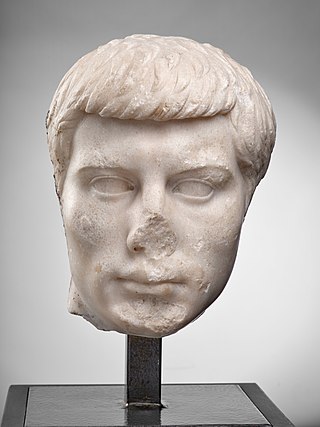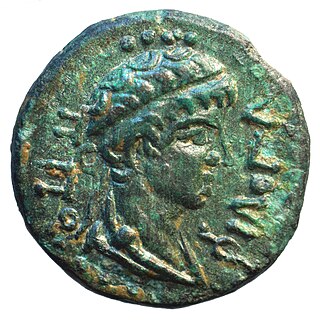Related Research Articles

Tiberius Julius Caesar Augustus was the second Roman emperor. He reigned from AD 14 until 37, succeeding his stepfather, the first Roman emperor Augustus. Tiberius was born in Rome in 42 BC. His father was the politician Tiberius Claudius Nero and his mother was Livia Drusilla, who would eventually divorce his father, and marry the future-emperor Augustus in 38 BC. Following the untimely deaths of Augustus' two grandsons and adopted heirs, Gaius and Lucius Caesar, Tiberius was designated Augustus' successor. Prior to this, Tiberius had proved himself an able diplomat, and one of the most successful Roman generals: his conquests of Pannonia, Dalmatia, Raetia, and (temporarily) parts of Germania laid the foundations for the empire's northern frontier.

The 10s decade ran from January 1, AD 10, to December 31, AD 19.

AD 15 (XV) was a common year starting on Tuesday of the Julian calendar. At the time, it was known as the Year of the Consulship of Caesar and Flaccus. The denomination AD 15 for this year has been used since the early medieval period, when the Anno Domini calendar era became the prevalent method in Europe for naming years.

AD 17 (XVII) was a common year starting on Friday of the Julian calendar. At the time, it was known as the Year of the Consulship of Flaccus and Rufus. The denomination AD 17 for this year has been used since the early medieval period, when the Anno Domini calendar era became the prevalent method in Europe for naming years.
AD 38 (XXXVIII) was a common year starting on Wednesday of the Julian calendar. At the time, it was known as the Year of the Consulship of Iulianus and Asprenas. The denomination AD 38 for this year has been used since the early medieval period, when the Anno Domini calendar era became the prevalent method in Europe for naming years.

Lucius Aelius Sejanus, commonly known as Sejanus, was a Roman soldier, friend and confidant of the Roman Emperor Tiberius. Of the Equites class by birth, Sejanus rose to power as prefect of the Praetorian Guard, of which he was commander from AD 14 until his execution for treason in AD 31.
Quintus Naevius Cordus Sutorius Macro was a prefect of the Praetorian Guard, from 31 until 38, serving under the Roman Emperors Tiberius and Caligula. Upon falling out of favour, he killed himself.

Tiberius Julius Caesar Nero Gemellus, known as Tiberius Gemellus was the son of Drusus and Livilla, the grandson of the Emperor Tiberius, and the cousin of the Emperor Caligula. Gemellus is a nickname meaning "the twin". His twin brother, Tiberius Claudius Caesar Germanicus II Gemellus, died as a young child in 23. His father and older cousins died, and are suspected by contemporary sources as having been systematically eliminated by the powerful praetorian prefect Sejanus. Their removal allowed Gemellus and Caligula to be named joint-heirs by Tiberius in 35, a decision that ultimately resulted in Caligula assuming power and having Gemellus killed in late 37 or early 38.

Claudia Livia was the only daughter of Nero Claudius Drusus and Antonia Minor and sister to Roman Emperor Claudius and general Germanicus, and thus paternal aunt of emperor Caligula and maternal great-aunt of emperor Nero, as well as the niece and daughter-in-law of Tiberius. She was named after her grandmother, Augustus' wife Livia Drusilla, and commonly known by her family nickname Livilla. She was born after Germanicus and before Claudius.

Drusus Julius Caesar was the son of Emperor Tiberius, and heir to the Roman Empire following the death of his adoptive brother Germanicus in AD 19.

Drusus Caesar was the adopted grandson and heir of the Roman emperor Tiberius, alongside his brother Nero. Born into the prominent Julio-Claudian dynasty, Drusus was the son of Tiberius' general and heir, Germanicus. After the deaths of his father and of Tiberius' son, Drusus the Younger, Drusus and his brother Nero Caesar were adopted together by Tiberius in September AD 23. As a result of being heirs of the emperor, he and his brother enjoyed accelerated political careers.

Nero Julius Caesar was the adopted grandson and heir of the Roman Emperor Tiberius, alongside his brother Drusus. Born into the prominent Julio-Claudian dynasty, Nero was the son of Tiberius' general and heir, Germanicus. After the deaths of his father and of Tiberius' son, Drusus the Younger, Nero and his brother Drusus were adopted together by Tiberius in September AD 23. As a result of being heirs of the emperor, he and his brother enjoyed accelerated political careers.
Tiberius Claudius Balbillus Modestus, more commonly known as Tiberius Claudius Balbilus, was a distinguished Ancient Roman scholar, politician and a court astrologer to the Roman emperors Claudius, Nero, and Vespasian.
Thrasyllus of Mendes, also known as Thrasyllus of Alexandria and by his Roman name Tiberius Claudius Thrasyllus, was an Egyptian grammarian and literary commentator. Thrasyllus was an astrologer and a personal friend of the Roman emperor Tiberius, as mentioned in the Annals by Tacitus and The Twelve Caesars by Suetonius.

Gaius Julius Antiochus Epiphanes Philopappos or Philopappus, was a Prince of the Kingdom of Commagene who lived in the Roman Empire during the 1st century and 2nd century. He was one of the most prominent Greeks in the Empire.

The Caesars is a British television series produced by Granada Television for the ITV network in 1968. Made in black-and-white and written and produced by Philip Mackie, it covered dramatic territory similar to that of the later BBC adaptation of I, Claudius, dealing with the lives of the early emperors of Ancient Rome, but differed in its less sensationalist depictions of historical characters and their motives; in particular, the Emperor Tiberius is portrayed much more sympathetically.
Lucius Arruntius Camillus Scribonianus was a Roman senator, who was active during the reign of Tiberius. He was consul in AD 32. Ten years later, he revolted against the emperor Claudius, but was swiftly defeated.
Claudia Capitolina was an Egyptian Greek woman who lived in the Roman Empire, in the 1st century and possibly in the 2nd century. She was a Princess of Commagene by marriage to Gaius Julius Archelaus Antiochus Epiphanes.
The gens Ennia was a family of Calabrian descent. It is known chiefly from a single individual, Quintus Ennius, a soldier, dramatist, and poet, whom the Romans came to regard as the father of their literature. Ennius was born at Rudiae, a village near Brundisium in Calabria, in 239 BC. He claimed descent from the ancient lords of Messapia. As a young man, he served as a soldier in the Roman army, rising to the rank of centurion. At the age of thirty-eight, he came to Rome in the train of Marcus Porcius Cato. Most of his works have been lost, or exist only in fragments, but he was greatly influential on later Roman writers, including Vergil.
Ennia Thrasylla, was a Roman noblewoman who lived in the 1st century AD in the Roman Empire.